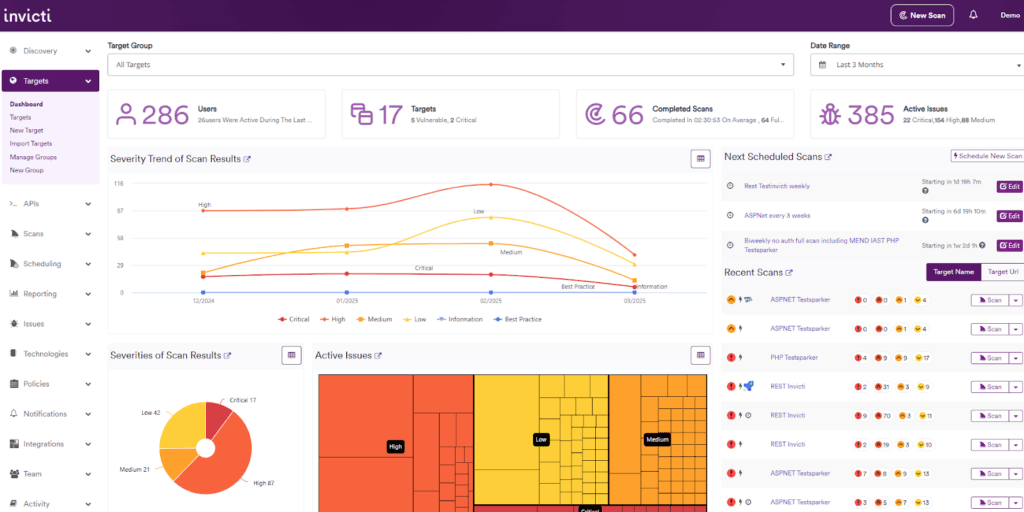Top 10 dynamic application security testing (DAST) tools for 2025
This guide explores the top 10 DAST tools for 2025, highlighting enterprise-grade solutions as well as open-source options. Learn how these tools help detect vulnerabilities, integrate with DevSecOps, and enhance web application security testing at every stage of the SDLC.

What is DAST and how does it work?
Dynamic application security testing (DAST) is a cybersecurity assessment method that analyzes running applications to identify vulnerabilities. Unlike static application security testing (SAST), which examines source code before deployment, DAST simulates real-world attacks by probing a web app’s inputs and responses. Note that while dynamic testing can be done manually or automatically, the term DAST is generally understood to mean automated testing using vulnerability scanners.
As a black-box testing approach, DAST is useful for detecting remotely exploitable application vulnerabilities like SQL injection and cross-site scripting (XSS) as well as runtime-specific security issues like misconfigurations and authentication flaws.
Why DAST-first is a better approach to AppSec
Most organizations rely mainly on SAST, software composition analysis (SCA), and other static scanning tools that flood developers and security teams with false positives and non-actionable findings—and that’s a problem:
- SAST and SCA don’t prove exploitability but do frequently generate hundreds of alerts without showing what can actually be reached and attacked.
- Developers get overwhelmed and waste time fixing low-risk issues instead of real threats—and eventually start treating all security warnings as false alarms.
- Security teams lack clear prioritization when you can’t separate critical issues from less urgent tasks and from sheer noise.
A DAST-first approach flips this on its head:
- DAST scanning focuses on what attackers see by probing live applications to find exploitable vulnerabilities.
- Automated validation confirms potential vulnerabilities with features like proof-based scanning to cut through false positives.
- Faster remediation and higher efficiency with short time to value as teams focus on first fixing what matters most.
Best DAST Tools for 2025
1. Invicti: Enterprise AppSec platform
Invicti provides an enterprise-grade, DAST-first application security platform with advanced automation. Its proprietary proof-based scanning technology automatically and safely confirms exploitable vulnerabilities, achieving a 99.98% accuracy rate and virtually eliminating false positives for these security flaws.
Invicti’s Predictive Risk Scoring helps prioritize testing and remediation based on risk of real-world exploitation, while vulnerability reports include detailed technical information and remediation guidance, not just generic CVSS scores. With over 50 integrations (including GitHub, Jira, ServiceNow, and Jenkins), Invicti seamlessly fits into existing workflows and CI/CD pipelines.

As a complete AppSec platform, Invicti supports modern web technologies, including JavaScript-heavy applications, SPAs, and all major API types (REST, SOAP, GraphQL, gRPC). It also incorporates IAST (interactive application security testing) for deeper coverage without code instrumentation. Invicti (formerly Netsparker) provides comprehensive security by supporting automated vulnerability scanning and vulnerability management in a continuous process across the software development lifecycle—all on a unified platform that also incorporates discovery.
Bonus tip: The Invicti DAST engine is also available as part of the Mend.io AppSec Platform, while the Invicti platform itself incorporates Mend’s SAST, SCA, and Container Security engines, enabling both platforms to provide broad vulnerability context and streamline remediation.
2. Acunetix by Invicti: DAST for SMBs

Acunetix by Invicti is a powerful DAST-only web vulnerability scanner tailored for smaller businesses and mid-sized enterprises just starting their application security programs. It provides fast, automated security testing at a price point accessible to SMBs.
Like Invicti, Acunetix features proof-based scanning to validate vulnerabilities and Predictive Risk Scoring to prioritize remediation. Its ease of use and rapid deployment make it an ideal entry point for companies beginning their AppSec journey.
3. Portswigger Burp Suite Enterprise

Burp Suite Enterprise enables automated scanning of web applications and APIs while maintaining access to Burp’s vulnerability detection capabilities and plugins. It supports integration with CI/CD pipelines but is primarily designed for security professionals, requiring expertise for optimal configuration. It lacks built-in API discovery and high-level compliance reporting, making it better suited for security teams and pentesting than development-driven DevSecOps environments.
4. Checkmarx DAST tools

Checkmarx DAST is part of a web application security suite that includes static and interactive security testing. It integrates with Checkmarx security intelligence for enhanced vulnerability detection and prioritization, complementing SAST tools and SCA for more holistic security coverage.
5. Rapid7 InsightAppSec

InsightAppSec is a cloud-based DAST solution designed for modern web applications and APIs, featuring dynamic attack simulations and SIEM integration to enhance threat response. Its automation capabilities help identify security flaws while integrating with DevOps workflows.
6. Tenable Web App Scanning (WAS)

Tenable WAS incorporates web application and API scanning into Tenable’s broader cyber exposure management suite, combining dynamic vulnerability detection with component-based fingerprinting. While usable for large-scale security programs, it’s traditionally security team-focused and may require customization for developer-driven DevSecOps workflows.
7. Qualys WAS

Qualys WAS offers vulnerability management across web applications and APIs as part of the Qualys Cloud Platform. It provides asset discovery and compliance reporting but relies on manual API specification updates and can be slow in large-scale environments.
8. Black Duck DAST tools

Black Duck, formerly known as Synopsys, offers two DAST products: Continuous Dynamic and Polaris fAST Dynamic. Continuous Dynamic is a DAST tool designed to identify security vulnerabilities in web applications by using automated scanning and analysis. Polaris fAST Dynamic is a separate DAST solution that focuses on streamlining the testing process for web applications.
9. Veracode Dynamic Analysis

Veracode‘s DAST solution offers continuous security testing through automated vulnerability detection, CI/CD integration, and regular scanning for ongoing protection, making it suitable for enterprises with stringent compliance requirements.
10. ZAP by Checkmarx (formerly OWASP ZAP)

ZAP (Zed Attack Proxy) is an open-source tool primarily suited for smaller projects, learning purposes, and penetration testing rather than large-scale enterprise deployments. It requires more manual configuration than enterprise tools but offers extensibility and strong community support. Several commercial DAST tools are based on ZAP.
The benefits of a DAST-first approach
Security isn’t about finding everything but about finding and addressing the right things. Taking a DAST-first approach with the right tools has major advantages:
- Cut through the noise: DAST finds and flags vulnerabilities that malicious hackers could actually use, showing you your realistic security posture.
- Work with verified and actionable issues: Exploitable vulnerabilities confirmed with proof-based scanning can be fixed without wasting time on verification.
- Secure more applications with less effort: Prioritize testing and remediation to first focus on high-risk assets and exploitable issues.
- Test everything regardless of technology: Tech-agnostic DAST lets you test your applications and APIs regardless of tech stack or programming language.
- Continuously test for vulnerabilities: Integrate DAST both into the SDLC and into production to build a continuous security testing process.
- Integrate with DevSecOps: Incorporate security into CI/CD pipelines and DevOps workflow.
Key features to look for in an enterprise DAST tool
When selecting a DAST tool that you intend to run in enterprise environments and on an enterprise scale, check if the following functionality is provided and matches your specific needs:
- Automated proof of exploit: Verifies vulnerabilities to eliminate false positives
- Predictive risk scoring: Prioritizes testing based on real-world impact
- Extensive integrations: Work in the tools and workflows your development teams already use
- Comprehensive API security: Supports modern API formats and authentication methods
- DevSecOps compatibility: Fits into CI/CD pipelines and development processes
- Actionable security issues: Provide clear remediation guidance for developers
- Compliance reporting: Helps meet regulatory requirements like PCI DSS, ISO 27001, SOC2, or HIPAA
Final thoughts: Start with DAST for real risk reduction
When selecting a security solution for your applications and APIs, ask yourself:
- Are you prioritizing vulnerabilities based on real risk across your attack surface?
- Can you validate exploitability or are you drowning in false positives?
- Are you fixing actual security issues or just reacting to incoming reports?
A DAST-first approach means finding, validating, and fixing real risks before attackers do—and having DAST on your side as your fact checker and force multiplier for all other AST tools.
Get the free AppSec Buyer’s Guide and detailed DAST checklist


